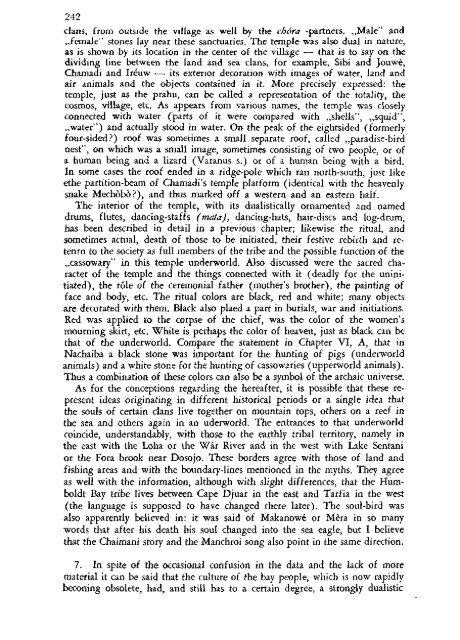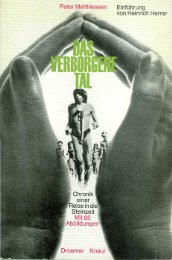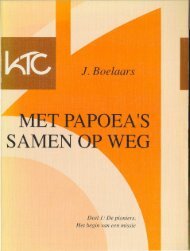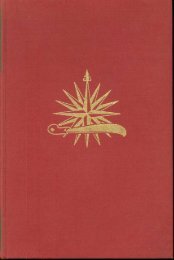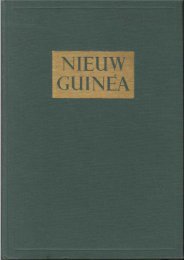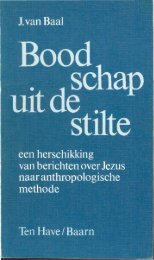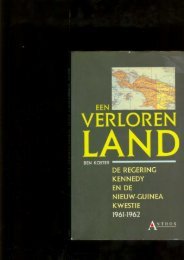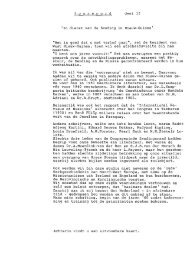Untitled - Stichting Papua Erfgoed
Untitled - Stichting Papua Erfgoed
Untitled - Stichting Papua Erfgoed
Create successful ePaper yourself
Turn your PDF publications into a flip-book with our unique Google optimized e-Paper software.
242<br />
clans, from outside the village as well by the chóra -partners. „Male" and<br />
„female" stones lay near these sanctuaries. The temple was also dual in nature,<br />
as is shown by its location in the center of the village — that is to say on the<br />
dividing line between the land and sea clans, for example, Sibi and Jouwé,<br />
Chamadi and Iréuw — its exterior decoration with images of water, land and<br />
air animals and the objects contained in it. More precisely expressed: the<br />
temple, just as the prahu, can be called a representation of the totality, the<br />
cosmos, village, etc. As appears from various names, the temple was closely<br />
connected with water (parts of it were compared with „shells", „squid",<br />
„water") and actually stood in water. On the peak of the eightsided (formerly<br />
four-sided?) roof was sometimes a small separate roof, called „paradise-bird<br />
nest", on which was a small image, sometimes consisting of two people, or of<br />
a human being and a lizard (Varanus s.) or of a human being with a bird.<br />
In some cases the roof ended in a ridge-pole which ran north-south, just like<br />
ethe partition-beam of Chamadi's temple platform (identical with the heavenly<br />
snake Mechòbò?), and thus marked off a western and an eastern half.<br />
The interior of the temple, with its dualistically ornamented and named<br />
drums, flutes, dancing-staffs (mata), dancing-hats, hair-discs and log-drum,<br />
has been described in detail in a previous chapter; likewise the ritual, and<br />
sometimes actual, death of those to be initiated, their festive rebirth and retenrn<br />
to the society as full members of the tribe and the possible function of the<br />
„cassowary" in this temple underworld. Also discussed were the sacred character<br />
of the temple and the things connected with it (deadly for the uninitiated),<br />
the role of the ceremonial father (mother's brother), the painting of<br />
face and body, etc. The ritual colors are black, red and white; many objects<br />
are decorated with them. Black also plaed a part in burials, war and initiations.<br />
Red was applied to the corpse of the chief, was the color of the women's<br />
mourning skirt, etc. White is perhaps the color of heaven, just as black can be<br />
that of the underworld. Compare the statement in Chapter VI, A, that in<br />
Nachaiba a black stone was important for the hunting of pigs (underworld<br />
animals) and a white stone for the hunting of cassowaries (upperworld animals).<br />
Thus a combination of these colors can also be a symbol of the archaic universe.<br />
As for the conceptions regarding the hereafter, it is possible that these represent<br />
ideas originating in different historical periods or a single idea that<br />
the souls of certain clans live together on mountain tops, others on a reef in<br />
the sea and others again in an uderworld. The entrances to that underworld<br />
coincide, understandably, with those to the earthly tribal territory, namely in<br />
the east with the Loha or the Wár River and in the west with Lake Sentani<br />
or the Fora brook near Dosojo. These borders agree with those of land and<br />
fishing areas and with the boundary-lines mentioned in the myths. They agree<br />
as well with the information, although with slight differences, that the Humboldt<br />
Bay tribe lives between Cape Djuar in the east and Tarfia in the west<br />
(the language is supposed to have changed there later). The soul-bird was<br />
also apparently believed in: it was said of Makanowé or Mèra in so many<br />
words that after his death his soul changed into the sea eagle, but I believe<br />
that the Chaimani story and the Manchroi song also point in the same direction.<br />
7. In spite of the occasional confusion in the data and the lack of more<br />
material it can be said that the culture of the bay people, which is now rapidly<br />
beconing obsolete, had, and still has to a certain degree, a strongly dualistic


